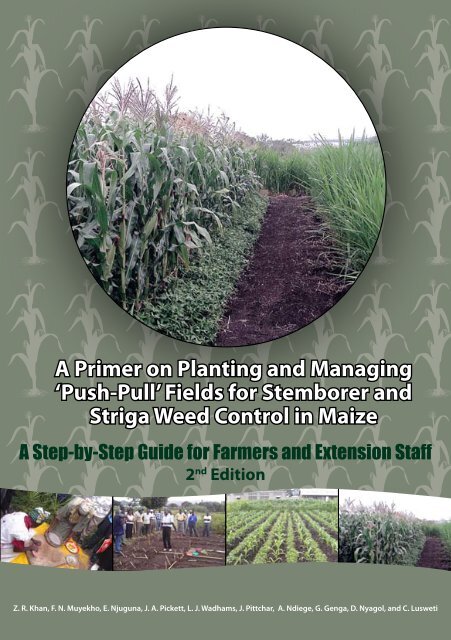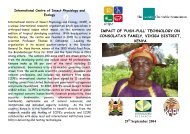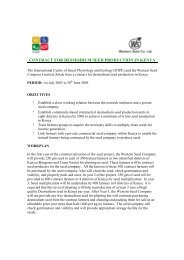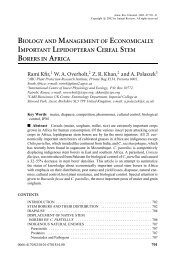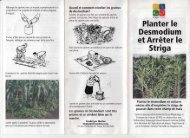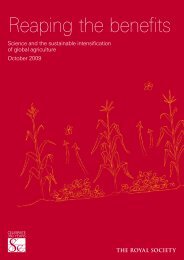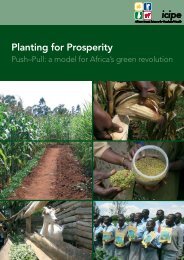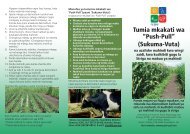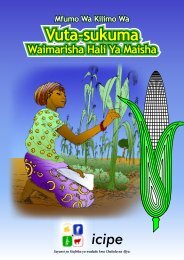A Primer on Planting and Managing 'PushâPull' Fields for Stemborer ...
A Primer on Planting and Managing 'PushâPull' Fields for Stemborer ...
A Primer on Planting and Managing 'PushâPull' Fields for Stemborer ...
- No tags were found...
You also want an ePaper? Increase the reach of your titles
YUMPU automatically turns print PDFs into web optimized ePapers that Google loves.
A <str<strong>on</strong>g>Primer</str<strong>on</strong>g> <strong>on</strong> <strong>Planting</strong> <strong>and</strong> <strong>Managing</strong>‘Push‐Pull’ <strong>Fields</strong> <strong>for</strong> <strong>Stemborer</strong> <strong>and</strong>Striga Weed C<strong>on</strong>trol in MaizeA Step-by-Step Guide <strong>for</strong> Farmers <strong>and</strong> Extensi<strong>on</strong> Staff2 nd Editi<strong>on</strong>Z. R. Khan, F. N. Muyekho, E. Njuguna, J. A. Pickett, L. J. Wadhams, J. Pittchar, A. Ndiege, G. Genga, D. Nyagol, <strong>and</strong> C. Lusweti
A <str<strong>on</strong>g>Primer</str<strong>on</strong>g> <strong>on</strong> <strong>Planting</strong> <strong>and</strong> <strong>Managing</strong>‘Push‐Pull’ <strong>Fields</strong> <strong>for</strong> <strong>Stemborer</strong> <strong>and</strong> StrigaWeed C<strong>on</strong>trol in MaizeA Step-by-Step Guide <strong>for</strong> Farmers <strong>and</strong>Extensi<strong>on</strong> Staff2 nd Editi<strong>on</strong>Z. R. Khan a , F. N. Muyekho b , E. Njuguna b , J. A. Pickett c , L. J. Wadhams c ,J. Pittchar a , A. Ndiege a , G. Genga a , D. Nyagol a , <strong>and</strong> C. Lusweti baInternati<strong>on</strong>al Centre of Insect Physiology <strong>and</strong> Ecology (ICIPE), NairobibKenya Agricultural Research Institute (KARl)cRothamsted Research, UKdMinistry of Livestock <strong>and</strong> Fisheries Development, KenyaD<strong>on</strong>ors: Kilimo Trust, Ug<strong>and</strong>a; Gatsby Charitable Foundati<strong>on</strong>, UK; <strong>and</strong>Biovisi<strong>on</strong>, Switzerl<strong>and</strong>
A <str<strong>on</strong>g>Primer</str<strong>on</strong>g> <strong>on</strong> <strong>Planting</strong> <strong>and</strong> <strong>Managing</strong> ‘Push-Pull’ <strong>Fields</strong> <strong>for</strong><strong>Stemborer</strong> <strong>and</strong> Striga C<strong>on</strong>trol in Maize—A Step-by-Step Guide<strong>for</strong> Farmers <strong>and</strong> Extensi<strong>on</strong> Staffby Z. R. Khan, F. N. Muyekho, E. Njuguna, J. A. Pickett, L. J. Wadhams, J. Pittchar,A.Ndiege, G. Genga, D. Nyagol <strong>and</strong> C. LuswetiISBN: 92 9064 1959Copyright © 2007 Internati<strong>on</strong>al Centre of Insect Physiology <strong>and</strong> Ecology.All rights reserved2nd editi<strong>on</strong> in illustrated <strong>for</strong>m. First published in 2005 in full colourICIPE Science PressP. O. Box 72913-00200Nairobi, KenyaTel.: +254 (20) 8632000Fax: +254(20) 8632001/2E-mail: isp@icipe.orgEdited by:Design <strong>and</strong> layout:Editorial assistance:Illustrati<strong>on</strong>s:A. Ng’eny-MengechNyotumba B<strong>on</strong>aventureD. OsogoSkyward Marketing Ltd.
CONTENTSList of Illustrati<strong>on</strong>s...................................................................ivForeword....................................................................................vi<strong>Stemborer</strong>s <strong>and</strong> Striga Weeds..............................................1<strong>Stemborer</strong>s............................................................................1Striga weeds..........................................................................6C<strong>on</strong>trol of <strong>Stemborer</strong>s <strong>and</strong> Striga Weeds Using a‘Push‐Pull’ Strategy...................................................................9What is ‘push-pull’?.............................................................9Benefits of adopting a push-pull strategy ............. 11How to Establish a Push-Pull Plot.................................... 13Step 1. L<strong>and</strong> preparati<strong>on</strong>............................................... 13Step 2. <strong>Planting</strong> material............................................... 14Step 3. <strong>Planting</strong> the push-pull crops......................... 16Step 4. Weeding................................................................ 21Step 5. Management of Napier grass........................ 25Step 6. Harvesting of maize.......................................... 27Step 7. Management of desmodium........................ 27Step 8. Harvesting <strong>and</strong> processingdesmodium seed............................................... 30<strong>Planting</strong> Push-Pull During the Sec<strong>on</strong>d <strong>and</strong> SubsequentSeas<strong>on</strong>s..................................................................................... 34Step 1. L<strong>and</strong> preparati<strong>on</strong>............................................... 34Step 2. <strong>Planting</strong> the sec<strong>on</strong>d crop ofpush-pull............................................................... 35Step 3. Weeding................................................................ 36Step 4. Management of Napier grass........................ 37Step 5. Management of desmodium........................ 38Feeding Your Cow................................................................. 38Things Not To Do................................................................... 40Frequently Asked Questi<strong>on</strong>s............................................. 41Glossary..................................................................................... 46iii
IllUSTRATIONSFigure 1. Adult stemborer moths of Busseola fusca (a) 1<strong>and</strong> Chilo partellus (b)Figure 2. Maize plant damaged by stemborer larvae 2FIgure 3. Deadheart caused by stemborer larvae 3feeding inside maize plantsFigure 4. A stem borer larva feeding inside a maize 4stemFigure 5. Life cycle of the stemborer Bussela fusca 5Figure 6. Life cycle of the stemborer Chilo partellus (the 5spotted stemborer)Figure 7. A maize field infested with Striga herm<strong>on</strong>thica 6Figure 8. Striga weed attached to maize roots 8Figure 9. More stemborers moths are attracted to 10Napier grass than to maize. Napier there<strong>for</strong>eacts as the ‘pull’ in push-pullFigure 10. Napier leaves attacked by stemborer10larvae (a). The larvae are killed by the stickysubstance produced from Napier grass (b).Figure 11. Layout of a push-pull plot 13Figure 12. Clean Napier grass root splits <strong>and</strong> cane 14Figure 13. Diseased Napier grass 15Figure 14. Newly planted Napier grass field 16Figure 15. Diagram of a planted push-pull field 18Figure 16. A farmer making rows <strong>for</strong> drilling desmodium 19seedsFigure 17. A farmer mixing desmodium seed with dry 19soil or s<strong>and</strong> <strong>for</strong> drilling.Figure 18. Farmers drilling <strong>and</strong> covering the desmodium 20seedsFigure 19. One-week-old silverleaf desmodium <strong>and</strong> 21greenleaf desmodium plantsiv
FIgure 20. Three-week-old silverleaf desmodium <strong>and</strong> 22greenleaf desmodium plantsFIgure 21. H<strong>and</strong> weeding desmodium rows <strong>and</strong> weeding 22the space betweenmaize <strong>and</strong> desmodiumwith a hoeFIgure 22. A push-pull plot after the first weeding 23Figure 24. Five-week-old silverleaf desmodium <strong>and</strong> 24greenleaf desmodium plantsFigure 23. Push-pull plot after sec<strong>on</strong>d weeding 24Figure 25. Farmers start harvesting Napier grass when it 25is 3 m<strong>on</strong>ths oldFigure 26. Cutting of the inner row of Napier grass while 26leaving the two outer rowsFigure 27. Harvesting desmodium <strong>for</strong>age after27harvesting maize from the fieldFigure 28. Flowering/podding desmodium after28harvesting maizeFigure 29. Harvesting of desmodium pods 30Figure 30. Sun drying of desmodium seeds 31Figure 31. Threshing of desmodium seeds 31Figure 32. Winnowing desmodium seeds 32Figure 33. Storing desmodium seeds 33Figure 34. Push-pull plot ready <strong>for</strong> planting maize during 34the sec<strong>on</strong>d seas<strong>on</strong>Figure 35. Newly planted push-pull plot during the 35sec<strong>on</strong>d seas<strong>on</strong>Figure 36. Chopping Napier <strong>and</strong> desmodium <strong>for</strong>age <strong>for</strong> 38feeding cows <strong>and</strong> goatsFigure 37. Cows feeding <strong>on</strong> chopped Napier mixed with 39desmodium <strong>for</strong>age.Figure 38. Dairy goats with chopped Napier mixed with 39desmodium in a troughv
FOREWORD<strong>Stemborer</strong>s <strong>and</strong> striga weed are the major pests of maizethroughout Africa. Maize yield losses due to stemborers canvary from 20-40%. Striga weed infests 40% of arable l<strong>and</strong> inthe savanna regi<strong>on</strong>, causing an annual crop loss of 7 to 13billi<strong>on</strong> dollars. Around the Lake Victoria basin, infestati<strong>on</strong> bystriga weed causes 30 to 100% loss in maize yield.Spraying <strong>for</strong> stemborer c<strong>on</strong>trol with pesticides is not <strong>on</strong>lyexpensive <strong>and</strong> harmful to the envir<strong>on</strong>ment, but is alsoineffective. Weeding <strong>for</strong> striga c<strong>on</strong>trol is both time-c<strong>on</strong>suming<strong>and</strong> labour-intensive.The ‘push-pull’ habitat management approach – developedby ICIPE, in partnership with several instituti<strong>on</strong>s includingthe Kenya Agricultural Research Institute (KARI), the KenyaMinistry of Agriculture <strong>and</strong> Rothamsted Research UK, exploitschemical ecology <strong>and</strong> biodiversity in a novel manner to limitcrop losses to stemborers <strong>and</strong> striga weeds. At same time, itc<strong>on</strong>serves soil <strong>and</strong> water while preserving biodiversity.The ‘push-pull’ technology involves trapping stemborers <strong>on</strong>highly attractant trap plants (the pull) <strong>and</strong> driving them awayfrom the maize crop using repellant intercrops (the push).Plants which repel stemborers as well as inhibit striga, havealso been identified. These plants also provide high qualityfeed <strong>for</strong> livestock, thereby increasing their productivity interms of meat <strong>and</strong> milk. On-farm trials with over 10,000 farmersin eastern Africa have c<strong>on</strong>firmed that these approachesc<strong>on</strong>ducted separately <strong>and</strong> together, result in significant yieldincreases.vi
‘Push-pull’ is a ‘plat<strong>for</strong>m technology’ around which otheragricultural innovati<strong>on</strong>s can develop to bring about anoverall improvement in the farming systems <strong>and</strong> livelihoods.It simultaneously reduces crop losses; improves productivity,household nutriti<strong>on</strong> <strong>and</strong> incomes; it enables increasedproducti<strong>on</strong> of livestock fodder; addresses soil fertilityc<strong>on</strong>straints <strong>and</strong> enables a minimum tillage system.The technology has been disseminated through differentpathways to enable as many farmers as possible learn aboutit, including print media, radio, farmer teachers, drama, fielddays <strong>and</strong> farmer field schools. Practical guides such as thish<strong>and</strong>book, a flyer <strong>on</strong> how to plant <strong>and</strong> manage a ‘Push-pull’field, <strong>and</strong> the ‘push-pull’ farmer field school curriculum havealso been published.This h<strong>and</strong>book is published to guide farmers <strong>and</strong> fr<strong>on</strong>tlineextensi<strong>on</strong> staff <strong>on</strong> how to establish <strong>and</strong> manage a ‘push-pull’plot to c<strong>on</strong>trol stemborer <strong>and</strong> striga weed. It is expected thatthese will enhance adopti<strong>on</strong> of the technology <strong>and</strong> increasemaize <strong>and</strong> livestock productivity while improving soil fertility<strong>and</strong> c<strong>on</strong>serving the envir<strong>on</strong>ment.ICIPE <strong>and</strong> the authors of this h<strong>and</strong>book gratefully acknowledgethe financial support from various d<strong>on</strong>ors – the Kilimo Trust,Ug<strong>and</strong>a; Gatsby Charitable Foundati<strong>on</strong>, UK; <strong>and</strong> Biovisi<strong>on</strong>,Switzerl<strong>and</strong> – that have enabled us to develop <strong>and</strong> catalyzethe disseminati<strong>on</strong> of the ‘push-pull’ technology in easternAfrica.Prof. Christian BorgemeisterDirector GeneralInternati<strong>on</strong>al Centre of Insect Physiology <strong>and</strong> EcologyNairobi, Kenyavii
<strong>Stemborer</strong>s <strong>and</strong> Striga Weeds<strong>Stemborer</strong>s <strong>and</strong> striga weeds are the two most destructivepests of cereal crops <strong>and</strong> can greatly reduce yields of maize<strong>and</strong> sorghum <strong>on</strong> smallholder farms. These pests can causeyield losses of 30 to 100% if they are not c<strong>on</strong>trolled. C<strong>on</strong>trolof stemborers by insecticides <strong>and</strong> c<strong>on</strong>trol of striga weeds byherbicides is very expensive <strong>for</strong> resource-poor farmers <strong>and</strong>can also be harmful to the envir<strong>on</strong>ment.<strong>Stemborer</strong>s<strong>Stemborer</strong>s are the most important insect pests of maize inAfrica, but they also attack other cereal crops such as sorghum,millet <strong>and</strong> sugarcane. In eastern Africa there are two species ofstemborers which cause heavy damage to cereal crops:abFigure 1. Adult stemborer moths of Busseola fusca (a) <strong>and</strong>Chilo partellus (b)1
Busseola fusca (Figure 1a) <strong>and</strong> Chilo partellus (Figure 1b).Busseola fusca is indigenous to Africa <strong>and</strong> is present in high<strong>and</strong> mid‐altitude areas (3500ft [1077m] above sea level <strong>and</strong>higher). Chilo partellus accidentally came to Africa from Asiain the 1930s. Chilo partellus is present in low <strong>and</strong> mid‐altitudeareas (zero to 4000ft [1230 m] above sea level).Damage is caused by the worm-like larvae, which first feed <strong>on</strong>young leaves (Figure 2), but so<strong>on</strong> enter into the stems.Figure 2. Maize plant damaged by stemborer larvae2
During the early stage of crop growth, the larvae may kill thegrowing points of the plant, resulting in deadheart (Figure 3).At a later stage of growth, the larvae make extensive tunnelsinside the stem (Figure 4). This weakens the stalk so that itbreaks <strong>and</strong> ‘lodges’ (falls over). Damage caused by stemborersaverages 20 to 40% which means between 2-4 bags of maizeare lost out of every 10 that could be harvested.FIgure 3. Deadheart caused by stemborer larvaefeeding inside maize plants3
Figure 4. A stem borer larva feeding inside a maize stemThe adult moths of stemborers (Figure 1) are seldom seen infarmers’ fields as they are inactive during daytime. They becomeactive after sunset <strong>and</strong> lay their eggs during the night.Adult moths lay their eggs <strong>on</strong> maize plants; after the larvaeemerge, they feed <strong>on</strong> leaves <strong>for</strong> two to three days <strong>and</strong> thenenter inside the maize stem (Figure 4). Busseola fusca laysits eggs between the stem <strong>and</strong> leafsheath, whereas ‘Chilopartellus lays its eggs <strong>on</strong> the leaf surface in the <strong>for</strong>m of eggbatches (Figures 5 <strong>and</strong> 6). After the larvae bore into the maizestems, they feed <strong>and</strong> grow within the stems <strong>for</strong> 2-3 weeks.When the larvae are fully grown, they pupate <strong>and</strong> remaininside the maize stem. After 7-14 days the adults emerge fromthe pupae <strong>and</strong> come out of the stem. They mate <strong>and</strong> lay eggs<strong>on</strong> the maize plants again <strong>and</strong> c<strong>on</strong>tinue damaging the crop.4
Pupadevelopsinto mothMoth layseggs <strong>on</strong>plants. Egg tolarva in 5-7daysLarva turns intopupa. Remains<strong>for</strong> 7-14 days aspupaEgg hatches intolarva. Larva feeds <strong>on</strong>plants <strong>and</strong> growsFigure 5. Life cycle of the stemborer Bussela fuscaAdult mothMoth layseggs <strong>on</strong> plantPupaLarvaFigure 6. Life cycle of the stemborer Chilo partellus(the spotted stemborer)5
Striga weedsStriga or ‘witchweeds’ are parasitic weeds that affect cerealcrops in many parts of Africa, reducing producti<strong>on</strong> from 30 to100%, or complete loss of the crop. If maize plants are attackedby both stemborers <strong>and</strong> striga weed, the yield loss is often100%. In East Africa, there are two comm<strong>on</strong> species of thewitchweed, Striga herm<strong>on</strong>thica (Figure 7) <strong>and</strong> Striga asiatica.Striga herm<strong>on</strong>thica is comm<strong>on</strong> around the Lake Basin, whileStriga asiatica is mainly found in the coastal areas. The mostaffected crops are maize, sorghum, rice <strong>and</strong> sugarcane.Figure 7. A maize field infested with Strigaherm<strong>on</strong>thica6
When a farm is infested with striga, the affected plants seldomgrow more than <strong>on</strong>e foot (30 cm) tall. The weed does notput roots into the soil so as to grow <strong>on</strong> its own, but grows byattaching itself <strong>on</strong>to the host (e.g. maize) plant (Figure 8).Each striga plant can produce up to 20,000-50,000 seeds, whichlie dormant in the soil until a cereal crop is planted again. Thisdormancy can last <strong>for</strong> over 15 years. As striga germinates, itsroots grow towards the host crop. They penetrate that crop’sroots <strong>and</strong> start to draw nutrients from the host. ‘This causessevere stunting of the host crop <strong>and</strong> yield loss.7
Striga flowerFigure 8. Striga weed attached to maize rootsTaking into account the peculiar nature of striga seeds, farmersare advised to c<strong>on</strong>trol it be<strong>for</strong>e the weed emerges above thesoil. The reas<strong>on</strong> <strong>for</strong> this is that by the time it emerges, much ofthe damage to the maize will have been caused.Although various c<strong>on</strong>trol methods have been proposed, theyare usually not successful. For example, although manualremoval of the striga reduces re-infestati<strong>on</strong>, it is c<strong>on</strong>sideredunec<strong>on</strong>omical since most damage is d<strong>on</strong>e even be<strong>for</strong>e theweed emerges. There<strong>for</strong>e, any c<strong>on</strong>trol strategy has to beginwithin the soil.8
C<strong>on</strong>trol of <strong>Stemborer</strong>s <strong>and</strong> Striga WeedsUsing a ’Push‐Pull’ StrategyWhat is ‘push-pull’?ICIPE <strong>and</strong> her partners have developed an effective, low-cost<strong>and</strong> envir<strong>on</strong>mentally friendly technology known as ‘push-pull’<strong>for</strong> the c<strong>on</strong>trol of stemborers <strong>and</strong> suppressi<strong>on</strong> of striga weedsin maize. It is a simple cropping strategy, whereby farmers useNapier grass <strong>and</strong> desmodium legume (silverleaf <strong>and</strong> greenleafdesmodium) as intercrops.Desmodium is planted in between the rows of maize. Itproduces a smell or odour that stemborer moths do not like.The smell ‘pushes’ away the stemborer moths from the maizecrop.Napier grass (Pennisetum purpureum) is planted around themaize crop as a trap plant. Napier grass is more attractive tostemborer moths than maize <strong>and</strong> it’ pulls’ the moths to laytheir eggs <strong>on</strong> it (Figure 9). But Napier grass does not allowstemborer larvae to develop <strong>on</strong> it. When the eggs hatch<strong>and</strong> the small larvae bore into Napier grass stems, the plantproduces a sticky substance like glue which traps them, <strong>and</strong>they die (Figure 10). So, very few stemborer larvae survive <strong>and</strong>the maize is saved because of the ‘push-pull’ strategy.In additi<strong>on</strong>, a ground cover of desmodium (Desmodiumuncinatum, or silverleaf), interplanted am<strong>on</strong>g the maize,reduces striga weed. Research has shown that chemicalsproduced by the roots of desmodium are resp<strong>on</strong>sible <strong>for</strong>suppressing the striga weed. There<strong>for</strong>e, striga does not growwhere desmodium is growing. Being a legume, desmodiumalso fixes nitrogen in the soil <strong>and</strong> thus acts to enrich the soil.9
Figure 9. More stemborers moths are attracted to Napier grassthan to maize. Napier there<strong>for</strong>e acts as the ‘pull’ in push-pullFeeding marks of stemborerlarvae <strong>on</strong> Napier grass<strong>Stemborer</strong> larvae killed byglue produced by Napiergrass stemFigure 10. Napier leaves attacked by stemborer larvae (a). The larvaeare killed by the sticky substance produced from Napier grass (b).10
Benefits of adopting a push-pull strategyWhen you adopt the push-pull strategy you will:• Increase maize yield by 25-30% -in the areas wherestemborers are the <strong>on</strong>ly problem. Where both stemborers<strong>and</strong> striga are problems, you can double your maize yields.• Increase the supply of cattle feed from harvesting Napiergrass <strong>and</strong> desmodium.• Fix nitrogen into your farm soil by desmodium legume, soyou save <strong>on</strong> fertiliser costs.• Protect soil from erosi<strong>on</strong>, as desmodium acts as a covercrop.• Retain soil moisture, as desmodium acts as a mulch.• Earn m<strong>on</strong>ey from the sale of desmodium seed at anattractive price of between Kshs 600 <strong>and</strong> 800 (US$ 8 to 10)per kg.• Make more m<strong>on</strong>ey from increased milk producti<strong>on</strong> <strong>and</strong>sales.• Save <strong>on</strong> farm labour, as you do not have to manually removestriga weed from the farm.• Protect maize from str<strong>on</strong>g winds, by surrounding it withNapier grass.11
How To Establish A Push-pull PlotStep 1. L<strong>and</strong> preparati<strong>on</strong>• Clear your l<strong>and</strong> during the dry seas<strong>on</strong>.• Plough <strong>and</strong> harrow your l<strong>and</strong> to a fine tilth (until the soilhas no large lumps) be<strong>for</strong>e the <strong>on</strong>set of the rains.• Desmodium has very small seeds; there<strong>for</strong>e the soil shouldbe carefully prepared so that it is as fine <strong>and</strong> clean aspossible.• Measure out your push-pull plot to a maximum size of 50by 50 m (Figure 11).• If you wish to layout a push-pull plot <strong>on</strong> l<strong>and</strong> that is largerthan 50 by 50 m, then measure out those pieces of l<strong>and</strong>into plots of maximum 50 x 50 m size.• If your l<strong>and</strong> is less than 50 by 50 m, the push pull technologywill still work; however, do not plant push-pull in plots lessthan 10 by 10 m as the Napier grass will have a shadingeffect <strong>on</strong> the maize crop.Area <strong>for</strong> planting Napiergrass around the maizeArea <strong>for</strong> maize<strong>and</strong> desmodiumintercropping1 meter path roundArea <strong>for</strong> planting Napiergrass around the maizeFigure 11. Layout of a push-pull plot13
Step 2. <strong>Planting</strong> materialEnsure that you have all the needed planting material:• Maize seed• Desmodium seed• Napier grass root splits or canes (Figure 12). The Banavariety is recommended. Ensure that the plot from whichyou are getting the planting material is not infected withNapier grass diseases (Figure 13)• Triple superphosphate or single superphosphate fertiliseror farmyard manure.Sources of planting material• Napier grass: KARl centres, Ministry of Agriculture, Ministryof Livestock <strong>and</strong> Fisheries Development, other farmers.• Desmodium: Western Seed Company Ltd., Kitale, Kenya.• Maize: Seed companies, Kenya Farmers Associati<strong>on</strong> (KFA)<strong>and</strong> appointed stockists.CanesRoot splitsInternodesFigure 12. Clean Napier grass root splits <strong>and</strong>cane cut into nodes <strong>for</strong> planting14
Healthy Napier grassDiseased Napier grassHealthy Napier grassDiseased Napier grassFigure 13. Diseased Napier grass plants are yellowish, stuntedplants with short internodes. The leaves are very narrow. Thedisease is carried by a micoorganism (phytoplasma) <strong>and</strong> istransmitted by an insect, which is not yet known15
Step 3. <strong>Planting</strong> the push-pull crops<strong>Planting</strong> Napier grass• Plant Napier grass (Bana variety is the best) in a borderaround the maize plot as shown in Figures 11 <strong>and</strong> 15.• Plant at least three rows of Napier all round the maize field.The spacing should be 75 cm between rows <strong>and</strong> 50 cmbetween Napier grass plants within a row (Figure 14).Hole ready <strong>for</strong> plantingPut in <strong>on</strong>e teaspo<strong>on</strong>ful of TSPfertiliser or two h<strong>and</strong>fuls offarmyard manure<strong>Planting</strong> Splits1¾ ft50cmPlace cane in the hole2½ ft75cmCover canewith soil afterplantingFigure 14. Newly planted Napier grass field16
• Apply <strong>on</strong>e teaspo<strong>on</strong>ful of triple superphosphate (TSP)fertiliser or two h<strong>and</strong>fuls of well decomposed farmyardmanure in each hole be<strong>for</strong>e planting Napier grass (Figure14).• Place a three-node cane into the ground, ensuring that twoof the nodes are covered, or place the root splits into theplanting holes <strong>and</strong> cover with soil (Figure 14).• In the first year, plant Napier grass be<strong>for</strong>e the rains so that ithas a start <strong>on</strong> the maize. The stemborer moths will like thelarger Napier grass <strong>for</strong> laying their eggs even more than themaize.<strong>Planting</strong> maize• Plant your maize in the field already surrounded by Napiergrass.• Ensure that the 1st row of maize is 1 m away from the innerrow of Napier grass.• The recommended spacing <strong>for</strong> maize is 75 cm betweenrows <strong>and</strong> 30 cm between hills in a row.• Apply <strong>on</strong>e teaspo<strong>on</strong>ful of triple superphosphate or twoteaspo<strong>on</strong>fuls of single superphosphate per hole.• Plant two maize seeds per hole <strong>and</strong> then thin to <strong>on</strong>e plantper hill after the first weeding.• Note: Napier rows should be planted so that they alternatewith maize rows (Napier should not be planted in the samerow with maize), so that ploughing of the field in the nextseas<strong>on</strong> will be easy (Figure 15).17
Figure 15. Diagram of maize <strong>and</strong> Napier grass not plantedin the same rowsHow to intercrop desmodium• You will need 1 kg of desmodium seed <strong>for</strong> 1 acre (0.4 ha) ofl<strong>and</strong>.• Desmodium is drilled in between the maize rows so that thedistance between the maize rows <strong>and</strong> desmodium rows is75 cm. Maize is planted first, followed by desmodium.• Using a str<strong>on</strong>g pointed stick, make a furrow 1-2 cm deepin the middle of the space between the rows of maize or inthe space where the maize will be planted (Figure 16).• Mix the desmodium with superphosphate fertiliser (about<strong>on</strong>e h<strong>and</strong>ful of seed <strong>and</strong> two h<strong>and</strong>fuls of fertiliser). If youcannot af<strong>for</strong>d fertiliser, then mix seed with fine s<strong>and</strong> (Figure17).• Sow the seed-s<strong>and</strong> or seed-fertiliser mixture into the furrowsyou have made <strong>and</strong> cover lightly with a small amount ofsoil (Figure 18).• A single row of desmodium should also be drilled <strong>on</strong> allsides of the outer rows of maize at an inter-row spacing of37.5 cm between the outermost maize row <strong>and</strong> the outerdesmodium row.18
30cm30cmMaize hill75cmMaize hillDesmodium rowFigure 16. A farmer making rows <strong>for</strong> drilling desmodium seedsDesmodiumseedsS<strong>and</strong>Figure 17. A farmer mixing desmodium seed with dry soil ors<strong>and</strong> <strong>for</strong> drilling. Use the ratio of 1 part seed to 3 parts s<strong>and</strong>19
Figure 18. Farmers drilling <strong>and</strong> covering the desmodium seeds• Plant desmodium with the rains <strong>for</strong> maximumgerminati<strong>on</strong>.• In areas where striga weed is NOT a problem, farmers canplant desmodium after every 3 or 5 rows of maize, <strong>and</strong> usethe other rows to plant beans. <strong>Stemborer</strong>s will still be keptaway from the maize.• In case you do not find desmodium seed, then you can usedesmodium root splits or cuttings from any neighbouringfarm. <strong>Planting</strong> of the splits or cuttings should be d<strong>on</strong>ewhen there is enough soil moisture to ensure goodestablishment.• To make a desmodium cutting, cut the stem of the motherplant so that it has at least two internodes.20
Step 4. Weeding1st weeding <strong>and</strong> crop management• Early weeding is very important <strong>for</strong> the successfulestablishment of a push-pull plot.• The first weeding should be carried out when the maize is3 weeks old.• It is important to know the difference between desmodium<strong>and</strong> weeds. If in doubt, c<strong>on</strong>sult the nearest extensi<strong>on</strong> staff.Figures 19 <strong>and</strong> 20 show young desmodium plants.• Care should be taken when weeding the drilled desmodiumline. H<strong>and</strong> picking of weeds in the line is recommended atthis stage (Figure 21).• Thin maize to <strong>on</strong>e plant per hill.• In striga-infested areas, apply nitrogen fertilizer (CAN) tothe maize at the rate of <strong>on</strong>e teaspo<strong>on</strong>ful per plant (Figure22) after the first weeding.• Napier grass rows should also be weeded.Figure 19. One-week-old silverleaf desmodium (left) <strong>and</strong>greenleaf desmodium (right) plants21
FIgure 20. Three-week-old silverleaf desmodium (left) <strong>and</strong>greenleaf desmodium (right) plantsFIgure 21. H<strong>and</strong> weeding desmodium rows <strong>and</strong> weeding thespace betweenmaize <strong>and</strong> desmodium with a hoe22
FIgure 22. A push-pull plot after the first weeding23
2nd weeding• The sec<strong>on</strong>d weeding should be d<strong>on</strong>e when the maize is 5weeks old (Figure 23).• Care should be taken again to distinguish betweendesmodium <strong>and</strong> weeds (Figure 24).• Napier grass rows should also be weeded again.• Top-dress the maize <strong>and</strong> Napier grass with CAN fertiliser atthe rate of <strong>on</strong>e teaspo<strong>on</strong>ful per plant.Figure 23. Push-pull plot after sec<strong>on</strong>d weedingFigure 24. Five-week-old silverleaf desmodium (left) <strong>and</strong>greenleaf desmodium (right) plants24
Step 5. Management of Napier grass• You can start harvesting Napier grass when it is 3 m<strong>on</strong>thsold or 1-1.5 metres high after planting (Figure 25).• Start with the inner row nearest the maize <strong>and</strong> harvest thisrow around the field first. Leave a stem height of 4 inches(10 cm) from the ground at harvesting to encourage it tore-grow quickly (Figure 26).• Feed this to your livestock. One dairy cow requires about50-70 kg of green Napier grass per day.• Always chop the fresh harvested Napier grass <strong>and</strong>desmodium to reduce wastage while feeding it to thelivestock.Figure 25. Farmers start harvesting Napier grasswhen it is 3 m<strong>on</strong>ths old25
Figure 26. Cutting of the inner row of Napier grass whileleaving the two outer rows• After the first <strong>for</strong>age has been harvested from the inner row,you can start harvesting the sec<strong>on</strong>d row. This gives time <strong>for</strong>the inner row to grow again.• The third row should be harvested <strong>on</strong>ly when the inner rowis again 1-1.5 m high. This will ensure that there is alwaysNapier grass of approximately 1-1.5 m high to trap the stemborers.• The inner row can be harvested again when it reaches 1-1.5m high, which means a period of 6-8 weeks between cuts.26
Step 6. Harvesting of maize• Harvest the maize <strong>on</strong>ce it attains maturity.• Maize stover (stalks) left over after crop harvest can be usedas livestock feed, particularly during the dry seas<strong>on</strong>. Alwaysstore the maize stover in a dry place to minimise spoilage.Step 7. Management of desmodium• After harvesting your maize crop, desmodium can eitherbe harvested as <strong>for</strong>age <strong>for</strong> livestock (Figure 27), or Left toproduce seed be<strong>for</strong>e it is harvested <strong>for</strong> <strong>for</strong>age (Figure 28).Figure 27. Harvesting desmodium <strong>for</strong>age after harvesting maizefrom the field27
Figure 28. Flowering/podding desmodiumafter harvesting maizeHarvesting desmodium <strong>for</strong> <strong>for</strong>age• When harvesting <strong>for</strong> <strong>for</strong>age, always cut the desmodiumvines so as to leave a stubble height of 6 cm above theground to encourage re-growth.• Chop the harvested desmodium <strong>and</strong> mix with Napier grassto reduce the wastage when feeding it to livestock.• When <strong>for</strong>age is in short supply, particularly during the dryseas<strong>on</strong>, chop the desmodium, Napier grass <strong>and</strong> maizestover <strong>and</strong> mix them be<strong>for</strong>e feeding to your livestock.• Cauti<strong>on</strong>: Never bring your livestock to graze in a push-pullfield as they will destroy the desmodium.28
Leaving desmodium <strong>for</strong> seed producti<strong>on</strong>• If your desmodium is flowering <strong>and</strong> podding, you may leaveit <strong>for</strong> seed producti<strong>on</strong>.• After harvesting the seed, you can harvest desmodium<strong>for</strong>age <strong>for</strong> livestock feed.• A farmer can get between 600-800 kg of green <strong>for</strong>age froma l-acre (0.4 ha) push-pull plot.• In areas were the dry seas<strong>on</strong> is not severe, <strong>on</strong>ly cut enoughdesmodium needed <strong>for</strong> your livestock each day. However inareas where the dry seas<strong>on</strong> is severe or l<strong>on</strong>g, cut the wholefield <strong>and</strong> make hay. C<strong>on</strong>sult your agricultural extensi<strong>on</strong>officer <strong>on</strong> how to make good quality hay.29
Step 8. Harvesting <strong>and</strong> processing desmodium seed• When <strong>and</strong> how to harvest the seed:Harvest the seed weekly <strong>on</strong>ce the pods have turnedbrown. H<strong>and</strong>-strip (Figure 29) the ripe pods <strong>and</strong> placeseeds in a tin.Sun-dry <strong>and</strong> then thresh the desmodium pods using ast<strong>on</strong>e <strong>and</strong> an old rubber shoe sole (Figures 30 <strong>and</strong> 31).Winnow to get clean seed (Figure 32).Store in dry, clean tin or airtight c<strong>on</strong>tainer (Figure 33).• One acre (0.4 ha) of well managed <strong>and</strong> properly harvesteddesmodium seed crop can yield 50-60 kg of seed. This canearn a farmer between Kshs 30,000 to 50,000 (US$ 400 to670) when sold at the current market price of Kshs 600 to800 per kg of seed.Figure 29. Harvesting of desmodium pods30
Figure 30. Sun drying of desmodium seedsFigure 31. Threshing of desmodium seeds<strong>on</strong> a st<strong>on</strong>e using an old slipper31
Figure 32. Winnowing desmodium seeds32
Figure 33. Store desmodium seed in a clean tin or airtightc<strong>on</strong>tainer• In areas where moles <strong>and</strong> rats (rodents) are a problem,after the first seas<strong>on</strong>'s harvesting, cut all the desmodium<strong>and</strong> Napier after harvesting the maize <strong>and</strong> feed to yourlivestock.33
<strong>Planting</strong> Push-Pull During the Sec<strong>on</strong>d <strong>and</strong>Subsequent Seas<strong>on</strong>sStep 1. L<strong>and</strong> preparati<strong>on</strong>• C<strong>on</strong>tinue cutting <strong>and</strong> utilising Napier grass, starting withthe inner row as be<strong>for</strong>e <strong>and</strong> weeding the cut Napier lines.• Apply farmyard manure or CAN fertiliser after cutting <strong>and</strong>weeding.• Cut back the desmodium <strong>and</strong> feed to livestock. . Clear thel<strong>and</strong> of maize stover <strong>and</strong> feed to livestock.• Be<strong>for</strong>e planting maize, dig or plough between the rows ofdesmodium. Care should be taken not to disturb / uprootthe desmodium lines as desmodium is a perennial crop(Figure 34).Figure 34. Push-pull plot ready <strong>for</strong> planting maizeduring the sec<strong>on</strong>d seas<strong>on</strong>34
Step 2. <strong>Planting</strong> the sec<strong>on</strong>d crop of push-pull• Plant maize in between desmodium rows at a spacing of 75x 30 em (Figure 35).• Apply TSP or DAP fertiliser <strong>on</strong> the maize at the rate of <strong>on</strong>eteaspo<strong>on</strong>ful per hill as top dressing.Figure 35. Newly planted push-pull plot during thesec<strong>on</strong>d seas<strong>on</strong>35
Step 3. Weeding1st weeding• Weed the maize when it is 3 weeks old. Napier grass <strong>and</strong>desmodium should also be weeded at this time.• Desmodium at this stage can smother maize if not trimmed.It is recommended that you trim it when the maize is 3weeks old.• Thin maize to <strong>on</strong>e plant per hill.• In striga-infested areas, top-dress the maize with CANfertiliser at the rate of <strong>on</strong>e teaspo<strong>on</strong>ful per hill.2nd weeding• The sec<strong>on</strong>d weeding should be d<strong>on</strong>e when the maize is 5-6weeks old.• Desmodium should be trimmed again at this stage.• Top-dress the maize with CAN fertiliser at a rate of <strong>on</strong>eteaspo<strong>on</strong>ful per hill.36
4. Management of Napier grass• C<strong>on</strong>tinue harvesting Napier grass <strong>for</strong> your livestock 6-8weeks after the <strong>on</strong>set of the rains.• Start cutting the inner row, followed by the middle row,then the outer row.• Always maintain a 1-metre high row of Napier grasssurrounding the tender maize, <strong>and</strong> be sure to give time <strong>for</strong>the previously cut row to grow be<strong>for</strong>e cutting the next.• Cauti<strong>on</strong>: Leaving maize without a Napier grass border orrow of 1-metre high will encourage stemborers to attackyour maize.Step 5. Management of desmodium• After the sec<strong>on</strong>d trimming (5-6 weeks after planting maize),leave the desmodium to grow until the maize is harvested.• The rest of the management practices are similar to those<strong>for</strong> the first seas<strong>on</strong>.• If you follow a good management regime <strong>for</strong> Napier grass<strong>and</strong> desmodium, you could benefit from your push-pullplot <strong>for</strong> 5 or more years.37
Feeding Your Cow• Chop the harvested Napier grass <strong>and</strong> desmodium to reducewastage while feeding it to your cow (Figure 36).• During the dry seas<strong>on</strong>, chop the maize stover into smallpieces <strong>and</strong> mix with the chopped Napier grass <strong>and</strong>desmodium.• Napier grass mixed with desmodium in the ratio of 3:1 isrecommended <strong>for</strong> higher milk producti<strong>on</strong> of your cows <strong>and</strong>goats (Figures 37, 38).• Two acres (0.8 ha) of a well managed push- pull plot can giveenough Napier grass <strong>and</strong> desmodium <strong>for</strong> <strong>on</strong>e dairy cow <strong>for</strong><strong>on</strong>e year, if supplemented with maize stover or other feedsduring the dry seas<strong>on</strong>.• Always remember to give your cow the recommendedmineral supplements.Figure 36. Chopping Napier <strong>and</strong> desmodium <strong>for</strong>age<strong>for</strong> feeding cows <strong>and</strong> goats38
Figure 37. Cows feeding <strong>on</strong> chopped Napier mixed withdesmodium <strong>for</strong>age. Mixing the small-leaved desmodium withNapier reduces wastage of the <strong>for</strong>merFigure 38. Dairy goats with chopped Napier mixed withdesmodium in a trough39
Things Not To Do1.Do not trim desmodium during the first seas<strong>on</strong>.2.3.4.Do not graze livestock in the push-pull plot, becauseanimals will destroy the Napier grass <strong>and</strong> desmodium.Do not intercrop desmodium with Napier grass in the samerow.Do not plant any other crop with the Napier grass.5. Do not allow desmodium to spread into the maize rowsin the sec<strong>on</strong>d <strong>and</strong> subsequent seas<strong>on</strong>s until the maize is 6weeks old. This reduces the competiti<strong>on</strong> between the twocrops.6. Never cut all the three rows of Napier together. This avoids‘windowing’. Always cut <strong>on</strong>e row all around your maize at atime.7. Do not let Napier grass over-grow because it will not beeffective in c<strong>on</strong>trolling stemborers <strong>and</strong> will become hard<strong>and</strong> coarse <strong>for</strong> cattle to feed <strong>on</strong>.8. Do not plough under the desmodium rows. Re planting thedesmodium is very expensive <strong>and</strong> is not necessary as it cangrow <strong>for</strong> up to 5 years or more.40
Frequently Asked Questi<strong>on</strong>sQ1. What is the maximum <strong>and</strong> minimum size of thepush‐pull plot?Answer:A push-pull plot can range from 50 x 50 m (minimum) or be used<strong>on</strong> any size farm provided the fields are demarcated into 50 x 50m secti<strong>on</strong>s using border rows of Napier grass.Q2. What is the minimum width of a push-pull plot?Answer:Not less than 10 metres (32 ft).Q3. How l<strong>on</strong>g can the push-pull plot be kept?Answer:If well managed, you can benefit from your push pull plot <strong>for</strong> 5 ormore years.Q4. Can I graze my cattle directly in the push pull plot?Answer:No. Grazing destroys desmodium <strong>and</strong> Napier grass.Q5. Can I practise push-pull’ if I d<strong>on</strong>’t have livestock?Answer:Yes, because you can sell the Napier <strong>and</strong> desmodium <strong>for</strong>age <strong>and</strong>seed to your neighbours <strong>and</strong> desmodium can improve the fertilityof your soil.41
Q6. Can I intercrop other crops <strong>and</strong> trees in the push-pullplot?Answer:Farmers can plant beans in the same hole with maize or inbetween maize plants in maize rows.Q7. Are there alternatives to Napier grass <strong>and</strong>desmodium?Answer:Yes. Forage sorghums such as Sudan grass (Sorghum vulgaresudanense) can be used to trap stemborers instead of Napiergrass. Molasses grass (Melinis minutiflora) can be used to repelstemborers instead of desmodium. Molasses grass does notc<strong>on</strong>trol striga weed, however.Q8. How l<strong>on</strong>g can desmodium survive in a prol<strong>on</strong>geddrought?Answer:Desmodium can always regenerate after a drought. However youare advised to plough <strong>and</strong> re-establish a push-pull plot in case of avery prol<strong>on</strong>ged drought or when desmodium fails to regenerate.Q9. Can I plant maize first, then Napier grass after a fewweeks?Answer:No. You are advised to plant Napier grass be<strong>for</strong>e planting maize,or if planting late, plant both crops at the same time.42
Q10. When do I start reaping the benefits of the push-pullplot?Answer:You can reap benefits during the sec<strong>on</strong>d cropping seas<strong>on</strong> in areaswhere farmers plant maize twice in a year, <strong>and</strong> during the sec<strong>on</strong>dyear in areas where farmers plant <strong>on</strong>ly <strong>on</strong>ce in a year.Q11. Can I use push-pull <strong>on</strong> sorghum?Answer:Yes. Intercrop green leaf desmodium (Desmodium intortum) withsorghum to repel stemborers <strong>and</strong> c<strong>on</strong>trol striga weed.Q12. Is push-pull effective against other weeds <strong>and</strong> insectpests?Answer:Desmodium in the push-pull strategy can reduce other weeds bysmothering them, but both Napier grass <strong>and</strong> desmodium maynot reduce other insect pests. This technology is most effectiveagainst stemborers <strong>and</strong> striga weed.Q13. Where can I obtain Napier grass <strong>and</strong> desmodiumseeds?Answer:Napier grass can be obtained from neighbouring farmers.Desmodium seed is sold by Western Seed Company Ltd., Kitale,Kenya.43
Q14. What can I do if I d<strong>on</strong>’t get desmodium seeds?Answer:Use desmodium root splits or cuttings from your neighbour.However ensure that you plant them immediately <strong>and</strong> whenthere is adequate soil moisture.Q15. How effective is push-pull against stemborers <strong>and</strong>striga weed?Answer:Push-pull is very effective. It is even better than insecticides <strong>for</strong> thec<strong>on</strong>trol of stemborers <strong>and</strong> better than manual removal of strigaweed, both in terms of cost <strong>and</strong> labour. Push-pull is the mosteffective c<strong>on</strong>trol.Q16. Can I be given a dairy animal if I establish a push-pullplot?Answer:No. But you can qualify <strong>for</strong> applying to various projects <strong>on</strong> dairyanimals.Q17. If I d<strong>on</strong>’t have desmodium seed, can I plant <strong>on</strong>ly Napiergrass in my push-pull plot?Answer:Yes. If you plant <strong>on</strong>ly Napier grass, you will be able to reducestemborers <strong>on</strong> maize, but you will not be able to c<strong>on</strong>trol strigaweed. However, using both Napier <strong>and</strong> desmodium gives the bestresults.44
Q18. Can the push-pull technology work in all parts of Kenyaor Africa?Answer:Yes, but <strong>on</strong>ly in areas recommended <strong>for</strong> growing desmodium.C<strong>on</strong>sult your agricultural extensi<strong>on</strong> staff.Q19. Can I use other varieties of Napier grass other thanBana grass?Answer:Yes. You can plant Cl<strong>on</strong>e 13 Napier grass, French Camero<strong>on</strong>,Kakamega 1, Kakamega 2 or Kakamega 3. But they are not asgood a trap plant as the Bana grass variety.Q20. Can I use other species of desmodium other thansilverleaf?Answer:Yes. You can use greenleaf desmodium (Desmodium intortum). Butthe results with silverleaf Desmodium uncinatum) intercroppedwith maize are the best. Greenleaf desmodium can be used indrier areas.45
GlossaryCANDAPdeadheartdrilling inemergenceftgreenleafhostindigenousinfestati<strong>on</strong> (ofstriga)internodes(<strong>for</strong> Napier ordesmodium)larva (pI. larvae)leafsheathlodgingmmanualmolasses grassnodecalcium amm<strong>on</strong>ium nitratediamm<strong>on</strong>ium phosphatedestructi<strong>on</strong> of the growing bud in the plantwhorl can result in a ‘deadheart’ -drying,stunting, <strong>and</strong> complete loss of yield by aplantto sow seeds in a furrow or trench in rowsthe process of emergence of a plant fromseedfeetgreenleaf desmodium (Desmodium intortum)an animal or a plant that maintains theparasitea plant or animal originating (native to) in anareapenetrati<strong>on</strong> of germinating seeds of strigainto the host rootpart of stem between two nodesnewly hatched worm-like <strong>for</strong>ms of insectswhich feed <strong>on</strong> plantsthe basal or lower part of the leaf enclosingthe stemdamaged plants due to heavy windsmetresby h<strong>and</strong>Melinis minutifloraan enlarged point <strong>on</strong> a stem where a leaf,bud, or other organ is attached46
parasitepupa (pI. pupae)silverleafstovertop-dressingTSPwitchweeda plant or an animal that grows, feeds <strong>and</strong> issheltered <strong>on</strong> or in a different plant or animalcalled the ‘host’inactive stage in the life cycle of stemborers,following the larval stagesilverleaf desmodium, Desmodium uncinatumdried stalks <strong>and</strong> leaves- of a cereal crop usedas a fodder after grain has been harvestedapplying fertiliser to the surface of the soiltriple superphosphate (fertiliser)parasitic weed such as Striga herm<strong>on</strong>thica47
For more in<strong>for</strong>mati<strong>on</strong>, c<strong>on</strong>tact:Director GeneralInternati<strong>on</strong>al Centre of Insect Physiology <strong>and</strong> Ecology (ICIPE)P. O. Box 30772-00100 Nairobi, KenyaTel: +254 (20) 8632000Fax: +254 (20) 8632001, 8632002E-mail: icipe@icipe.orgorHabitat Management ProgrammeICIPE-MbitaP. O. Box 30, MbitaSuba District, KenyaTel: +254 (59) 22217/18/95 Fax: +254(59)22190orDirectorKenya Agricultural Research InstituteP. O. Box 57811 Nairobi, KenyaTel: +254 (20) 4183301-20Fax: +254(20) 4183344E-mail: resourcecentre@kari.orgorCentre DirectorKenya Agricultural Research InstituteP. O. Box 450Kitale, KenyaTel: +254 (54) 20108orScientific Director,Rothamsted Centre <strong>for</strong> Sustainable Pest <strong>and</strong> Disease ManagementRothamsted Research,Harpenden, Herts., AL5 2JQ,United KingdomTel: +44 (0) 1582 763133 x2320Fax +44 (0) 1582 762595orDistrict Agricultural Officers48
This easy-to-read primer shows farmers how to manage two of the major pestsof maize-stem borers <strong>and</strong> striga weed-in the eastern <strong>and</strong> southern Africa regi<strong>on</strong>without the useof chemical pesticides. The ‘push-pull’ strategy is a novel systemof intercropping designed to manage the agroecohabitat <strong>for</strong> higher maize yields,while at the same time providing fodder, enriching the soil <strong>and</strong> c<strong>on</strong>servingboidiversityPush-pull can also be adapted <strong>for</strong> sorghum <strong>and</strong> millet fields <strong>and</strong> is an af<strong>for</strong>dable,appropriate <strong>and</strong> socially acceptable technology <strong>for</strong> use by Africa’s farmers.Z. R. Khan, F. N. Muyekho, E. Njuguna, J. A. Pickett, L. J. Wadhams, J. Pittchar, A. Ndiege, G. Genga, D. Nyagol <strong>and</strong> C. Lusweti


